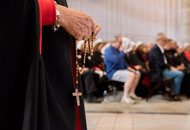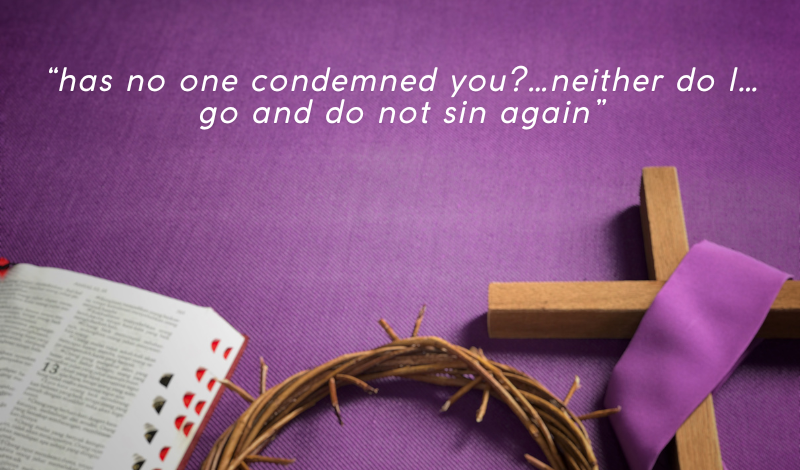“has no one condemned you?…neither do I…go and do not sin again”
Last week, we heard that wonderful parable about the prodigal son, and we might add, the prodigal father (in the sense that the father’s love seems almost prodigal, or overflowing, even wasteful!). We know that it was a parable about God’s love and mercy; a favorite theme in St. Luke’s Gospel. Indeed, Jesus preached this parable in close connection with two other parables about things being lost and then the rejoicing when they are found (the lost coin and the lost sheep). This week, we jump to St. John’s Gospel, not for a parable about God’s love and mercy, but rather that love and mercy in action or reality! Interestingly, the parable of the prodigal son occurs only in St. Luke’s Gospel and, similarly, the encounter between Jesus and the woman caught in adultery only occurs in Chapter 8 of St. John’s Gospel.
To unpack the deeper meaning of the encounter, it is well worth looking at more closely at the people involved and how the dynamics of the drama unfold. First of all, there is no doubt about the guilt of the woman: she was caught in the very act of committing adultery. We can only imagine her feelings and emotions as she is made a spectacle of, standing in the middle before the crowd and the religious leaders. There is a horrible sense too of violence and of fear. Whatever the intentions (malicious, as we will hear) of the religious leaders as they bring the woman before Jesus, we also can have no doubt about the clear penalty for adultery. According the Law, it was death by stoning. Incidentally, the man involved in this act should also be stoned: where is he if they were both caught together in the very act? It is also an attack on Jesus: a lose/lose situation: they did this to “test” Jesus. If he “acquits” the woman then he has broken the Law of Moses; if he condemns her then he has become part of the harsh system. We can imagine the tone of their voices as they say to Jesus, “so, what do you say?”
What happens next is amazing and it must have puzzled (or even irked) the religious leaders. Jesus says nothing, but rather bends down and begins writing on the ground. People have speculated for 2,000 years on why Jesus did this and, of course, what he wrote. Some think it may have been a passage from the Scriptures about God’s mercy, others that he began to write down the names and the sins of the religious leaders standing before him!
Whatever the case, the religious leaders persist with their question and the trap that they so carefully have laid for Jesus. Our Lord’s reply must have caught them completely unaware, “let the one among you who is without sin be the first to throw a stone at her.” Incidentally, we might note a supreme irony here for, after all, the only one there without sin is Jesus himself! We note that they go away, beginning with the elders or leaders. Some suggest that they realize that their trap has failed and they leave before they get into trouble. Others think that they are only too aware of their shortcomings and perhaps their faults of equal magnitude to the accused woman. There is hope indeed for them, as they have this ‘reality check” about their own lives and conduct. Perhaps in the future some of them may be less ready to judge and condemn and, instead, more ready to forgive others and to help them move from a wrong situation to something good.
Jesus is left alone with the woman (incidentally a man and a woman is this situation of being alone would be frowned upon in the culture of the time). The woman stands before him, just as we might stand before God. Our Lord almost seems surprised as he asks her “where are they?” We then hear Jesus’ words of both mercy and of justice: “neither do I condemn you…go, and from now on do not sin any more.” Notice that Jesus fully recognizes the wrong that she has done, but also lifts her condemnation.
This dramatic and powerful incident teaches us so much. For example, there is a danger that we can fall so easily into the trap of being judgmental or even of condemning others, especially those who have done wrong, or who do not share our viewpoints. Perhaps the greatest lesson is to understand better both God’s justice and God’s mercy. If we are honest, there is often no doubt, in justice, about our guilt; but we turn to God for forgiveness and mercy. Let us remember that the whole point about “mercy” is that it is undeserved and unmerited. If was deserved, it would not be mercy! We can receive this mercy especially in the sacrament of reconciliation. Let us remember though that this is no whitewash and that although our sins are absolved, we are not absolved from responsibility or from the call to holiness. As we say in the Act of Contrition before we receive the absolution, “we firmly intend, with God’s help, to sin no more and to avoid whatever leads us to sin.”
This reflection was written by Very Rev. Msgr. Anthony M. Barratt STL, PhD, EV, ChM.





